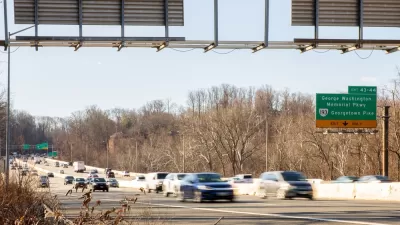Average vehicle miles driven rose in almost every major metropolitan area between 2019 and 2024.

The reduction in driving brought on by the pandemic doesn’t seem to be a lasting effect, writes Linda Poon in Bloomberg CityLab. In fact, between May 2019 and May 2024, total miles traveled (VMT) in the United States grew by 12 percent to the highest level ever recorded, according to a report from StreetLight Data.
The report also suggests that VMT is rising faster now than it was when driving levels first rebounded from the pandemic in 2021 — a worrying trend for advocates working to reform transportation, the largest contributor to US carbon emissions.
VMT grew in almost every U.S. metro area and in most central city neighborhoods, including a 14.7 percent growth in New York City’s core, highlighting the potential benefits of the city’s now-canceled congestion pricing plan.
Across the country, famously car-centric Los Angeles saw a 17 percent decline in average daily VMT. “Other areas among the top five are also in California, including the Oxnard-Thousand Oaks-Ventura area with a 16% decline and the San Francisco Bay Area with a 13% decline — though the study does not dive into potential reasons for the dips.”
Brookings senior fellow Adie Tomer says more work is needed to understand why these changes happen. “Declines in VMT could be a result of deliberate urban planning and infrastructure changes to rein in driving. They could also be a consequence of remote work policies and population shifts, not only away from the metro area but within it.”
FULL STORY: US Driving and Congestion Rates Are Higher Than Ever

Trump Administration Could Effectively End Housing Voucher Program
Federal officials are eyeing major cuts to the Section 8 program that helps millions of low-income households pay rent.

Planetizen Federal Action Tracker
A weekly monitor of how Trump’s orders and actions are impacting planners and planning in America.

Ken Jennings Launches Transit Web Series
The Jeopardy champ wants you to ride public transit.

California Invests Additional $5M in Electric School Buses
The state wants to electrify all of its school bus fleets by 2035.

Austin Launches $2M Homelessness Prevention Fund
A new grant program from the city’s Homeless Strategy Office will fund rental assistance and supportive services.

Alabama School Forestry Initiative Brings Trees to Schoolyards
Trees can improve physical and mental health for students and commnity members.
Urban Design for Planners 1: Software Tools
This six-course series explores essential urban design concepts using open source software and equips planners with the tools they need to participate fully in the urban design process.
Planning for Universal Design
Learn the tools for implementing Universal Design in planning regulations.
Ada County Highway District
Clanton & Associates, Inc.
Jessamine County Fiscal Court
Institute for Housing and Urban Development Studies (IHS)
City of Grandview
Harvard GSD Executive Education
Toledo-Lucas County Plan Commissions
Salt Lake City
NYU Wagner Graduate School of Public Service





























